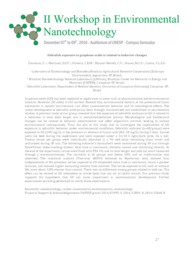Zebrafish exposure to graphene oxide is related to behavior changes.
Zebrafish exposure to graphene oxide is related to behavior changes.
Author(s): CLEMENTE, Z.; MARTINEZ, D. S. T.; OLIVEIRA, C. R. M.; MAURER-MORELLI, C. V.; NUNES, M. C. S.; CASTRO, V. L. S. S. de
Summary: Graphene oxide (GO) has been explored to application in areas such as pharmaceutical and environmental sciences. However, GO safety is still unclear. Beyond that, environmental factors, as the presence of humic substances in aquatic environment, can affect nanomaterials behavior and its toxicological effects. The motor development of zebrafish embryo has been strongly characterized and established to neurotoxicity studies. A previous study of our group revealed that the exposure of zebrafish embryos to GO is related to a reduction in total body length and in acetylcholinesterase activity. Morphological and biochemical changes can be related to behavior abnormalities and affect organism?s survival, leading to serious environmental consequences. Thus, the aim of this study was to investigate the implications of GO exposure in zebrafish behavior under environmental conditions. Zebrafish embryos (n=48/group) were exposed to GO (100 mg/L) in the presence or absence of humic acid (HA, 20 mg/L) during 5 days. Larvae were not feed during the experiment and were exposed under a 14/10 h light/dark cycle, 26 ± 1oC. Twelve larvae per group were individually allocated in a 96 well-plate containing clean water and acclimated during 30 min. The following behavior?s biomarkers were monitored during 30 min through DanioVision video-tracking system: total time in movement, distance moved and swimming velocity. At the end of the experiment, larvae were fixed with PFA 4% and its total length and yolk sac were measured through a stereomicroscope. The mortality in all groups was below 10% and no malformation was observed. The statistical analysis (Two-way ANOVA followed by Bonferroni test) showed that, independently of HA presence, larvae exposed to GO dispended more time in movement, swam a greater distance, and showed higher swimming velocity than controls. The larvae exposed to GO, with or without HA, were about 3.8% shorter than control. There was no difference among groups related to yolk sac. The effect can be related to GO adsorption to larvae body that can act as tactile stimuli. Our previous study supports the hypothesis that GO can cause impairment in neuromuscular development. Further experiments are being performed to clarify these observations.
Publication year: 2016
Types of publication: Abstract in annals or event proceedings
Unit: Embrapa Environment
Keywords: Ecotoxicology, Embryotoxicity, Nanomaterials, Nanotoxicology
Observation
Some of Embrapa's publications are published as ePub files. To read them, use or download one of the following free software options to your computer or mobile device. Android: Google Play Books; IOS: iBooks; Windows and Linux: Calibre.
Access other publications
Access the Agricultural Research Database (BDPA) to consult Embrapa's full library collection and records.
Visit Embrapa Bookstore to purchase books and other publications sold by Embrapa.

